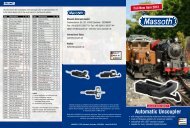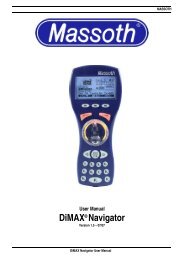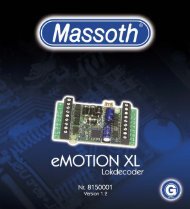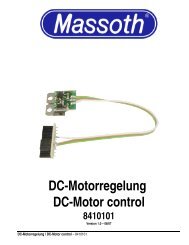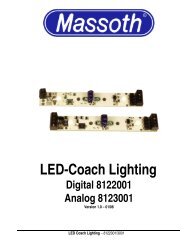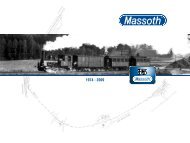User’s Manual DiMAX® 1200Z Digital Central Station
User's Manual DiMAX® 1200Z Digital Central Station - Massoth
User's Manual DiMAX® 1200Z Digital Central Station - Massoth
You also want an ePaper? Increase the reach of your titles
YUMPU automatically turns print PDFs into web optimized ePapers that Google loves.
MASSOTH<br />
Please note that in locos configured in 14 speed steps the light will not display correctly if they are controlled<br />
with 28 speed steps. The same is true for locos defined for 28 speed steps that are controlled with<br />
14 speed steps. In these cases the lights of the locomotives may flicker or may not work at all.<br />
3.4 Producing Special Functions<br />
The <strong>DiMAX®</strong> <strong>Digital</strong> System provides two kinds of function triggering: parallel and serial. The selection of<br />
the respective technique is made during the locomotive configuration via the<br />
<strong>DiMAX®</strong> Navigator or any other handheld controller.<br />
3.4.1 Producing Parallel Functions<br />
Parallel function triggering is standard in the NMRA DCC operation. Each function command is sent to the<br />
locomotive directly. Pushing the F1 key releases the function 1; the F2 key releases the function 2 and so<br />
on. The functions are produced immediately after pushing the key as there is only one single command to<br />
be sent to the locomotive.<br />
The number of functions has been changed during the last few years. It started out with 8 functions and<br />
was changed to 16 or more functions available. The <strong>DiMAX®</strong> <strong>Digital</strong> System is one of the few digital systems<br />
that support 16 functions according to the NMRA DCC Standard and the <strong>DiMAX®</strong> <strong>Digital</strong> System is<br />
ready to implement any further changes in the future.<br />
3.4.2 Producing Serial Functions<br />
Serial function triggering has a long story. Starting out as a single function triggered by one single key, the<br />
request for multiple functions resulted in the development of serial function triggering. As there was only<br />
one key available on the handheld controller, one had to push the same key repeatedly to get other functions.<br />
One had to push the key once for function #1, twice for function #2 and three times for function #3<br />
and so on. The F1 command was sent as a pulse string.<br />
Example 1:<br />
Example 2:<br />
The F1 key is pressed once and command #1 was sent once. Subsequently the<br />
whistle went off.<br />
The F1 key is pressed 5 times and the command was sent 5 times.<br />
Subsequently the function #5 was initiated.<br />
The higher the number of function, the more often the key had to be pushed. Therefore the delay between<br />
the command and the actual initiation depended on the value of the number of the command.<br />
Normally LGB® locomotives with serial sound function processing can be upgraded to parallel functions.<br />
3.5 Number of Locomotives in Simultaneous Operation<br />
The <strong>DiMAX®</strong> <strong>Digital</strong> System distinguishes between active and passive locomotives. Locomotives that are<br />
controlled by a <strong>DiMAX®</strong> Navigator or other handheld controller are active. Any command that is put into<br />
DiMAX ® <strong>1200Z</strong> <strong>Digital</strong> <strong>Central</strong> <strong>Station</strong> 7



